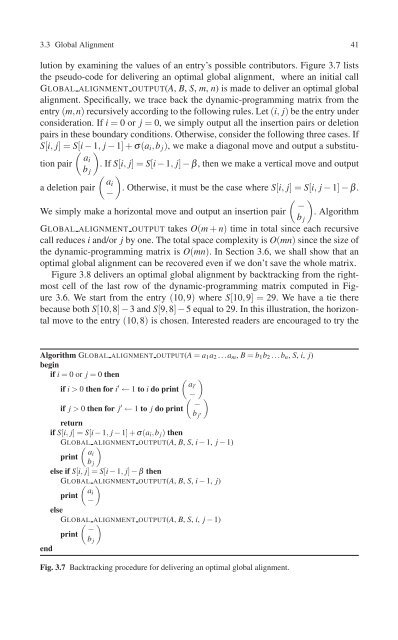You also want an ePaper? Increase the reach of your titles
YUMPU automatically turns print PDFs into web optimized ePapers that Google loves.
3.3 Global Alignment 41<br />
(<br />
ai<br />
b j<br />
)<br />
lution by examining the values of an entry’s possible contributors. Figure 3.7 lists<br />
the pseudo-code for delivering an optimal global alignment, where an initial call<br />
GLOBAL ALIGNMENT OUTPUT(A, B, S, m, n) is made to deliver an optimal global<br />
alignment. Specifically, we trace back the dynamic-programming matrix from the<br />
entry (m,n) recursively according to the following rules. Let (i, j) be the entry under<br />
consideration. If i = 0or j = 0, we simply output all the insertion pairs or deletion<br />
pairs in these boundary conditions. Otherwise, consider the following three cases. If<br />
S[i, j]=S[i − 1, j − 1]+σ(a i ,b j ), we make a diagonal move and output a substitution<br />
pair .IfS[i, j]=S[i − 1, j] − β, then we make a vertical move and output<br />
( )<br />
ai<br />
a deletion pair . Otherwise, it must be the case where S[i, j]=S[i, j − 1] − β.<br />
−<br />
We simply make a horizontal move and output an insertion pair<br />
(<br />
−<br />
b j<br />
)<br />
. Algorithm<br />
GLOBAL ALIGNMENT OUTPUT takes O(m + n) time in total since each recursive<br />
call reduces i and/or j by one. The total space complexity is O(mn) since the size of<br />
the dynamic-programming matrix is O(mn). In Section 3.6, we shall show that an<br />
optimal global alignment can be recovered even if we don’t save the whole matrix.<br />
Figure 3.8 delivers an optimal global alignment by backtracking from the rightmost<br />
cell of the last row of the dynamic-programming matrix computed in Figure<br />
3.6. We start from the entry (10,9) where S[10,9] =29. We have a tie there<br />
because both S[10,8]−3 and S[9,8]−5 equal to 29. In this illustration, the horizontal<br />
move to the entry (10,8) is chosen. Interested readers are encouraged to try the<br />
Algorithm GLOBAL ALIGNMENT OUTPUT(A = a 1 a 2 ...a m , B = b 1 b 2 ...b n , S, i, j)<br />
begin<br />
if i = 0or j = 0 then<br />
( )<br />
if i > 0 then for i ′ ai ′<br />
← 1 to i do print<br />
(<br />
−<br />
)<br />
if j > 0 then for j ′ −<br />
← 1 to j do print<br />
b j ′<br />
return<br />
if S[i, j]=S[i − 1, j − 1]+σ(a i ,b j ) then<br />
GLOBAL ( ALIGNMENT )<br />
OUTPUT(A, B, S, i − 1, j − 1)<br />
ai<br />
print<br />
b j<br />
else if S[i, j]=S[i − 1, j] − β then<br />
GLOBAL ( ALIGNMENT )<br />
OUTPUT(A, B, S, i − 1, j)<br />
ai<br />
print<br />
−<br />
else<br />
GLOBAL ( ALIGNMENT )<br />
OUTPUT(A, B, S, i, j − 1)<br />
−<br />
print<br />
b j<br />
end<br />
Fig. 3.7 Backtracking procedure for delivering an optimal global alignment.

















